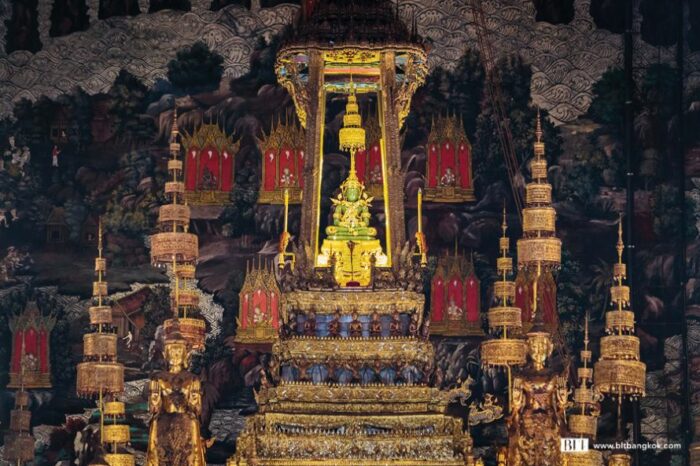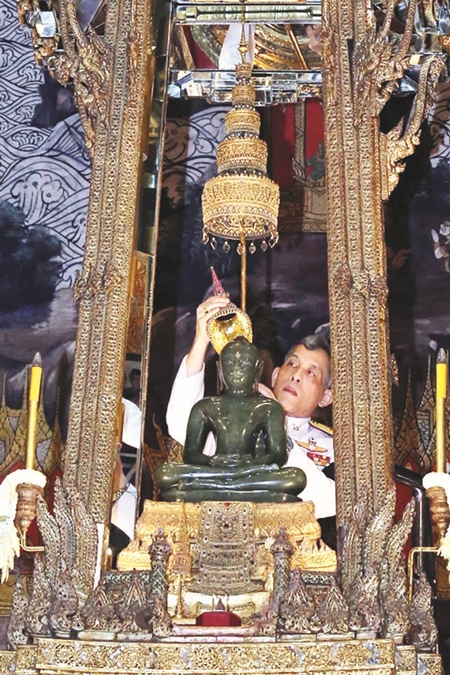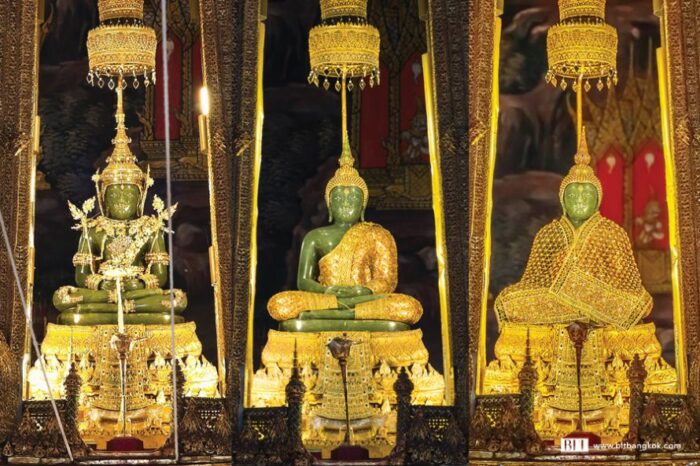
The Emerald Buddha: Legends, Beliefs, and History
The Emerald Buddha, also known as the Phra Phuttha Maha Mani Ratana Patimakorn, is a revered and historic Thai Buddha statue considered the palladium (protector) of Thailand. Traditionally believed to have been created around 500 CE by the monk Phra Nak Sen, it’s carved from a single block of green jade.
Legends surrounding the Emerald Buddha abound. Many tales claim it was crafted by divine beings. The “Rattana Bimbangsa” legend narrates that celestial figures presented the statue to Phra Nak Sen, an arhat (enlightened being) from the ancient Indian city of Pataliputra.
However, documented history for the Emerald Buddha begins in 1734 CE (1977 BE according to the Buddhist Era). Lightning struck a stupa (Buddhist reliquary) at Wat Pa Ya, Chiang Rai, revealing a stucco-covered and gilded Buddha image. Upon removing the plaster, a magnificent green jade Buddha statue was discovered.
The Journey of the Emerald Buddha:
- 1734 CE (1977 BE): Enshrined at Wat Pa Ya, Chiang Rai
- 1768 CE (2011 BE): Transported to Chiang Mai
- 1852 CE (2095 BE): Brought to Luang Prabang by King Sai Setthathirath
- 1864 CE (2107 BE): Moved to Vientiane
- 1782 CE (2321 BE): King Taksin (of Thonburi) retrieved the statue
- 1784 CE (2325 BE): King Rama I of Siam (present-day Thailand) permanently housed it at Wat Phra Kaew (Temple of the Emerald Buddha) in Bangkok. The Emerald Buddha serves as a powerful symbol of unity and a source of spiritual solace for the Thai people. It is believed to bring prosperity, success, and stability to the nation.
Additional Notes:
King Mongkut (Rama IV) of Siam authored a historical account of the Emerald Buddha. Scholars believe the statue was likely created by ancient Lanna artisans (northern Thai people).
The Emerald Buddha depicts the Buddha in a seated meditation posture (samadhi). It measures 48.03 centimeters (18.9 inches) wide and 66 centimeters (26 inches) tall from the base to the top of the head. The Emerald Buddha’s attire is changed three times a year according to the season.
The seasonal changing of the robes ceremony, performed on the Emerald Buddha three times a year, is a significant and symbolic ritual in Thailand. It’s a deeply ingrained tradition that blends religious reverence with royal authority.
Here is a thorough breakdown of the ceremony:
- Frequency: The ceremony takes place three times a year, coinciding with the changing seasons:Summer: During the hot season (typically in April)
- Rainy Season: During the start of the rainy season (around July/August)
- Winter: During the cool season (usually in November)Significance: The ceremony signifies respect and devotion towards the Emerald Buddha, a revered national treasure.
- Process: The ceremony is a highly ritualized event performed by the King of Thailand (or a designated representative) himself. It involves:
- Unveiling the Emerald Buddha from its current attire.
- Carefully cleansing the statue.
- Draping the Buddha in a new, elaborately embroidered robe specifically designed for the corresponding season.
- The new robe reflects the season’s characteristics:
- Summer: Lighter and cooler fabrics.
- Rainy Season: Fabrics that drape more generously, potentially symbolizing protection from the elements.
- Winter: Richer and warmer fabrics.
- Symbolism: The changing of robes goes beyond practicality. It’s believed to bring harmony and prosperity to the land based on the principle of aligning with the seasonal cycles.
- Public Significance: While the ceremony itself is a royal event, it holds significance for the entire nation. It’s a time for reflection, renewal, and hope for good fortune in the coming season.
The robes themselves are considered works of art, showcasing exquisite craftsmanship and intricate designs often incorporating gold threads and precious jewels.
The ceremony is a public spectacle observed with great reverence by the Thai people. It’s often accompanied by music, prayers, and offerings.


